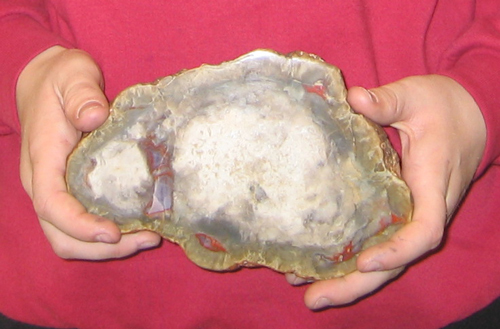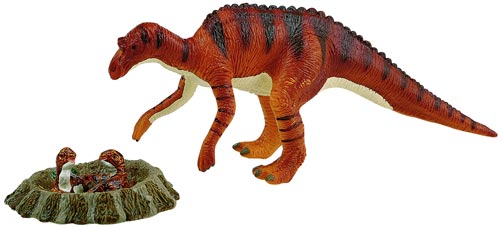Fossilised Dinosaur Wee and Poo Mapped In Brazil
A lot can be learned from the skulls, teeth and jaws of prehistoric animals. However, what goes in one end has to come out the other. Quite exactly how the dinosaurs voided their digestive tracts (went to the toilet), remains a mystery, but a pair of scientists based in Brazil have mapped the fossilised excreta associated with a number of Mesozoic formations in that South American country. The research has just been published in the “Journal of South American Earth Sciences”.
Urolites and Coprolites
So let’s get down and dirty with the Dinosauria. Many people might be aware that fossilised faeces are called coprolites. The word coprolite comes from ancient Greek, it means “dung stone” from the words kopros for dung and lithos for stone. We suspect that rather less people are aware that trace fossils believed to represent displaced sediment as a result of a stream of urine coming from a vertebrate are referred to as urolites. The word urolite is also derived from the Greek. Uro meaning urine and lithos for stone.
The Joy of Studying Coprolites
Picture credit: Everything Dinosaur
Studying Unique Trace Fossils
Back in 2004, the two scientists responsible for this latest research paper, Marcelo Adorna Fernandes (University of São Carlos), and Paul Roberto Figueiredo Souto (University of Rio de Janeiro), published a ground-breaking study (no pun intended) into trace fossils believed to be represent the disturbance caused in sand when a stream of urine hits that spot. These traces of animal behaviour were preserved as fossils and so scientists had the opportunity to study the patterns made from splashes of urine.
The urolite fossils studied in 2004 and also examined in this latest paper, come from Cretaceous sandstone deposits of São Paulo State, in south-eastern Brazil (Botucatu Formation). They have been found in association with the fossilised footprints of two different types of dinosaurs, a meat-eating theropod and an ornithopod. It is not known which type of dinosaur created the urolites.
Studies of Urolites and Experiments to Recreate Sediment Redistribution
Picture credit: The Society of Brazilian Palaeontology (2004)
The above photographs show three trace fossils that are believed to correspond to liquid wastes (A, B and C). Photograph D shows an excavation created by dropping two litres of water from a height of eighty centimetres as the scientists experimented to try to recreate the impressions. In all of the photographs the scale bar is in centimetres.
Anatomical Advantage of the Dinosauria
One of the reasons why scientists believe that the dinosaurs came to dominate life in the Mesozoic is that they were very efficient at retaining moisture inside their bodies compared to other types of terrestrial vertebrates . Most types of birds excrete very little water with their faeces. In fact, the way in which birds and reptiles deal with processing waste products, particularly those wastes and toxins associated with protein digestion, differs from the way that mammals handle the problem of expelling waste.
Ammonia, a by-product of protein digestion, is toxic, it has to be got rid of. Mammals convert ammonia in the body into a concentrated form (urea), this is expelled as urine, but it means we lose water. Reptiles and birds tackle the problem of getting rid of ammonia in a slightly different way. These other types of amniotes convert the ammonia into uric acid, which is much less toxic than urea.
It therefore does not need to be diluted with water to such an extent. Indeed, uric acid does not need to mix with any water at all, it can be excreted as a semi-solid and thus, a lot of water can be conserved in this way.
The internal plumbing of birds and reptiles also varies. Crocodiles and some types of Ratite, such as the Ostrich, can expel urine and faeces separately, the urine first followed by the solids (usually). Most birds and most reptiles tend to expel what liquid they wish to get rid of as well as any solids at the same time. Kind of a “one flush system” as we call it. The mystery about dinosaur waste elimination is this – did the Dinosauria expel urine and faeces separately like ostriches and crocodiles or were they to a “one flush system”?
Perhaps different types of dinosaur expelled waste in different ways. Ostriches for example, can store their urine in a urodeum, an organ similar in function to the mammalian bladder. The solid waste is stored in another organ called a coprodeum, this is eliminated subsequently to the urine expulsion.
Observations of Ostriches Spending a Penny
Observations of Ostriches spending a penny as it were, shows that they produce a strong jet of urine that hits the ground with quite a force. They create similar patterns in unconsolidated soil as seen in the trace fossils found in the Botucatu Formation (pictures A, B and C above).
So why bother to map the places in Brazil where coprolites and urolites are found? These fossils provide important evidence to palaeontologists. They help scientists build up a picture of the diet of vertebrates and evidence of plant remains as well as depositional data can provide information about the palaeoclimates. For example, the sandstones of the Botucatu Formation where the urolites were found, represent a dune environment interspersed with oasis and wadis.
In this latest research paper, coprolites from Upper Cretaceous as well as potential Jurassic aged deposits have been mapped. This all helps to extend our knowledge with regards to the Gondwana biota during the Mesozoic.
Putting Brazil’s Coprolites and Urolites on the Map
Picture credit: Journal of South America Earth Sciences/annotation by Everything Dinosaur
This area of research is often overlooked. There is a lot we do not know about the Dinosauria. Take for example the Late Cretaceous hadrosaurine dinosaur Maiasaura (Maiasaura peeblesorum). The Two Medicine Formation of Montana provided an extraordinary amount of evidence about this ornithopod and its nesting behaviour.
“Egg Mountain”
The fossil deposit location was referred to as “egg mountain”, as these sediments preserved evidence of huge nesting colonies. In addition, this location is one of very few in the world where large amounts of coprolite directly associated with a single genus was discovered. It seemed appropriate as well as polite to nick-name these highly fossiliferous sites “egg mountain”, naming the location “*h!# mountain” would have been scientifically valid, but perhaps not as acceptable in popular literature.
Lots of Coprolite Fossils Associated with Maiasaura (M. peeblesorum)
Picture credit: Everything Dinosaur
For dinosaur models and replicas: Wild Safari Prehistoric World Models.
The only other locations where urolites associated with the Dinosauria have been described (as far as we know), are France and Germany.










Leave A Comment